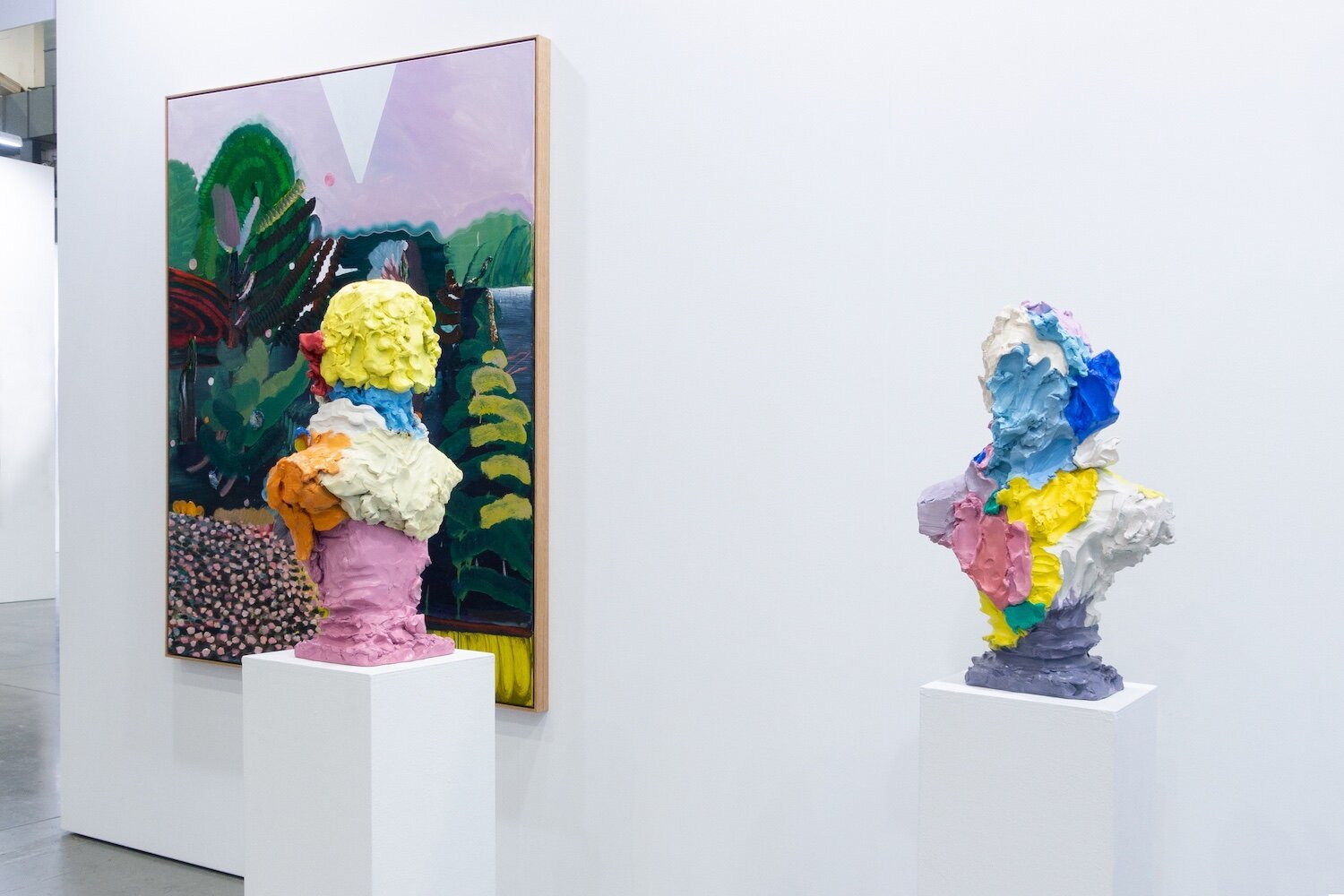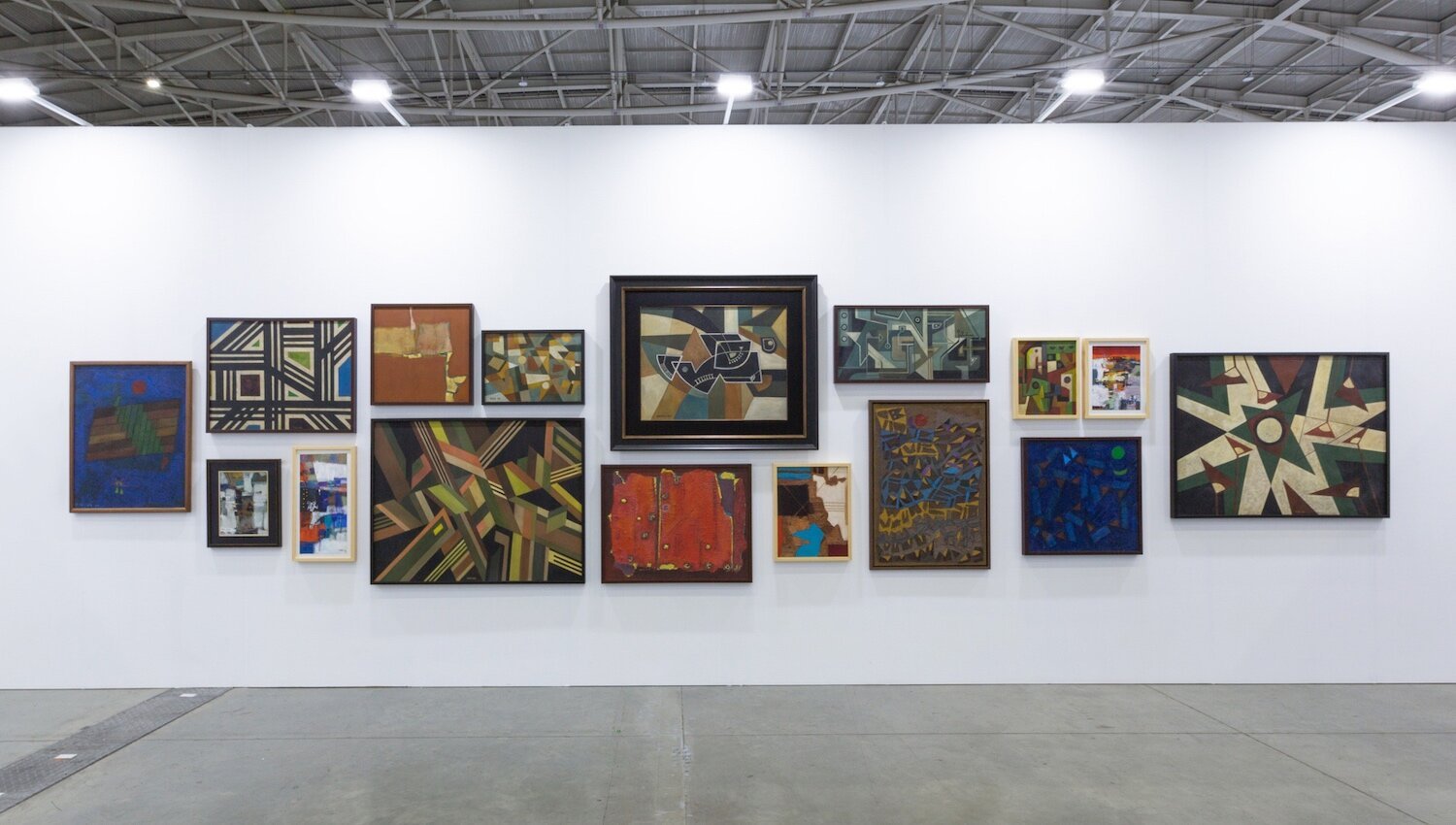Southeast Asia at Taipei Dangdai
Clear presence in 2020 with room to grow
By Vivyan Yeo
The second edition of Taipei Dangdai concluded on 19 January 2020 with the participation of 99 galleries from across the globe and over 40,000 visitors. This turnout was a 30% increase from the inaugural edition last year. With its strong Asian collector base, Taipei Dangdai 2020 presented a critical opportunity for Southeast Asian galleries and artists to introduce themselves to a burgeoning art market.
Marina Cruz, ‘Fruits from the Heart’, 2019, oil on canvas, 122 x 91.5cm. Image courtesy of Mind Set Art Center, Taiwan.
Ramesh Mario Nithiyendran, ‘Figure with Purple Head’, 2019, earthenware, glaze and lustre, 68 x 25 x 20 cm. Image courtesy of Sullivan+Strumpf, Sydney | Singapore.
Southeast Asian galleries performed well, with works from both within the region and beyond. Sullivan+Strumpf offered a unique perspective with artists from a range of countries, including Indonesia, Sri Lanka, India, Australia and Denmark. Almost half the booth sold out. “We thoroughly enjoyed the atmosphere of the fair and greeted a steady flow of sophisticated clients throughout the three-day event,” says Director Ursula Sullivan. “Sullivan+Strumpf enjoyed strong sales, from high-end works by established artist Sam Jinks through to works by emerging artists Ramesh Mario Nithiyendran and Irfan Hendrian.”
Installation view of Yavuz Gallery’s booth. Image courtesy of Yavuz Gallery, Singapore.
Taipei Dangdai 2020 was an ideal space for Southeast Asian galleries to expand within the Asian artistic ecosystem. Yavuz Gallery, which has spaces in both Sydney and Singapore, elected to focus on artists from Australia and New Zealand. This comprised of artists such as Guy Maestri and Caroline Rothwell. Caryn Quek, executive of Yavuz Gallery, noted that the fair was well organised and curated, and allowed the gallery to meet many local and international collectors.
Two galleries curated solo shows dedicated to Southeast Asian artists. One was Manila-based Artinformal, which spotlighted JC Jacinto, a distinguished artist interested in the autonomous life of nature. “It was the first time for Artinformal to join Taipei Dangdai and get to know a bit Taiwanese culture,” says founder Tina G. Fernandez. The gallery sold all of the works to Filipino buyers due to the artist’s strong following in the Philippines, but Taipei Dangdai was still productive to introduce his work to a new audience. She adds, “The Taiwanese audience had a sincere desire to get to know the art of JC Jacinto. They asked in-depth questions and wanted to follow through on the artist’s career. All in all, it was a great experience.”
The other gallery with a Southeast Asian focus was Taipei-based Mind Set Art Center, which presented a solo show on Filipino artist Marina Cruz. The exhibition sold out to collectors based in Taiwan and Switzerland. With both a gallery booth and a solo booth, Mind Set Art Center was one of the few that exhibited artists from both East Asia and Southeast Asia. “The new works on display by Rao Fu, Shi Jin- Hua and Tang Jo-Hung went to private collections,” says Queena Chu, director of Mindset Art Center. Indicative of a positive outlook following the fair, the gallery received a considerable number of inquiries about their artists. While it was a good outing for Mind Set Art Center all in all, Chu expressed that many collectors did not attend the fair because of its proximity to the Lunar New Year celebrations.
Despite its timing, the variety of art within Taipei Dangdai attracted the attendance of many Southeast Asian collectors. These included Filipino collectors such as Bryan Ang and Timothy Tan, as well as Singaporean collectors Yip Lam Yang, Leong Wah Keong, Adrian Chan and Ryan Su, among others.
Installation view of Asia Art Center’s booth. Image courtesy of Asia Art Center, Singapore.
Facilitating a similar dialogue between East Asian and Southeast Asian artworks, Asia Art Centre worked together with Singapore-based art advisory Art Agenda S.E.A. to present Indonesian post-war abstract works, paintings from the Japanese Mono-ha group and prominent Taiwanese works from Dong Shaw-hwei, Yang Chihung and Li Chen. “The works of Fadjar Sidik, Handrio and Umi Dachlan were well received by the crowd, and this exposure allowed for collectors beyond Southeast Asia to grow in familiarity with each of the artists’ unique aesthetics,” says Chua Chingyi, Art Advisor at Art Agenda, S.E.A. “We were able to place numerous pieces within new Asian collections.”
Similarly, Taipei-based Nunu Fine Art was one of the few galleries to present artists from across the world. They exhibited artists such as Peter Zimmermann, Kaspar Bonnén and Petah Coyne, alongside British-Philippine artist Maya Hewitt. “We focus on promoting emerging artists in Southeast Asia and Latin America,” says founder Nunu Hung. “We hope that in the future, we can have the opportunity to introduce even more artists from other nations to the people in Taiwan.”
Outside the fair, Southeast Asian works were also exhibited in art spaces in Taipei. TKG+ organised an exhibition titled “Plus X”, which ran concurrently with Taipei Dangdai. Set alongside Taiwanese contemporary artworks, the gallery presented Burmese artist Sawangwongse Yawnghwe and Thai artist Mit Jai Inn, who have both previously held solo exhibitions with TKG+. At Winsing Art Place, which features the collection of Jenny Yeh, founder of Winsing Arts Foundation, was Vietnamese- Danish artist Danh Vo’s first solo exhibition in Taipei. A highlight of the show was ‘We the People’, in which a 1:1 copper replica of the Statue of Liberty had been disassembled into over 300 pieces and sent to various countries to be exhibited.
The visibility of Southeast Asian art in and around Taipei Dangdai proves to be promising, as they position Taiwan to be a hotspot for art from the region. Looking to the third edition, it would be heartening to see more Southeast Asian galleries and art represented in the fair in 2021.
Click here to read our preview on Taipei Dangdai 2020.
Click here to read the preview, and here to read our report on Taipei Dangdai 2019.










